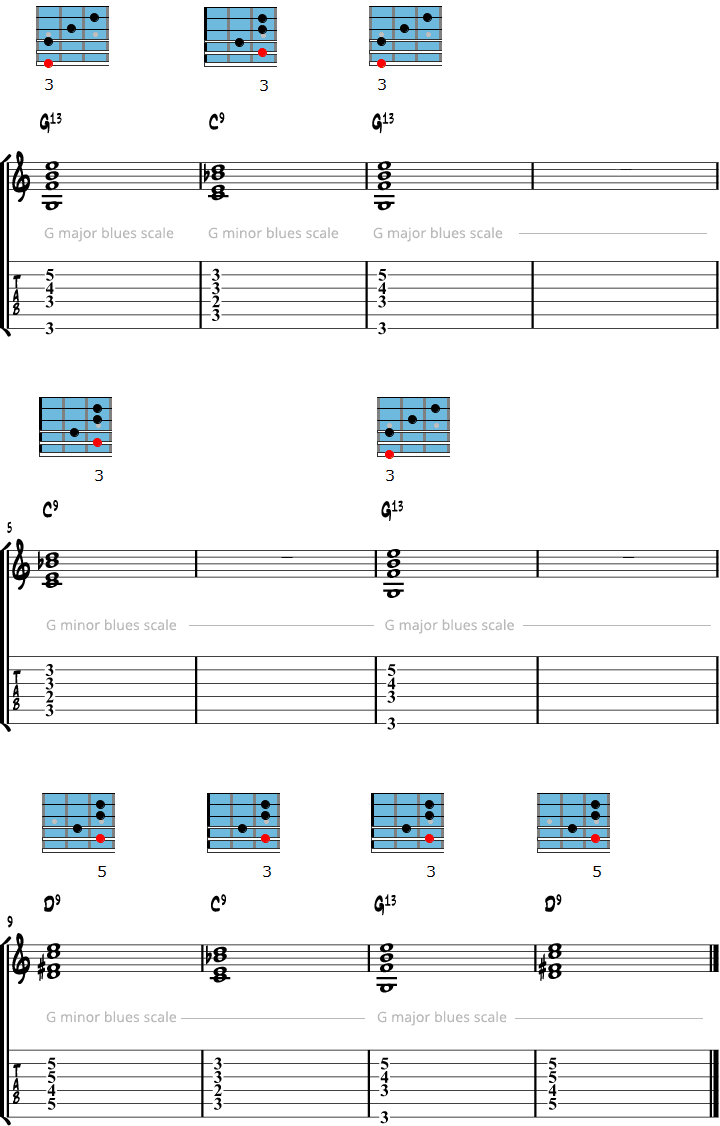The first thing I learned to play on guitar was the blues, and I guess that’s the case for the majority of guitar players. Blues has it all, it has a very expressive form and sound and is the best place to master the core elements of jazz playing, such as keeping the form, giving each chord its own sound and the use of substitutes.
One of the difficulties I had during my early years of guitar playing was transitioning from playing the minor pentatonic scale over the entire blues form to giving each chord its own sound and making the blues sound jazzy.
In this free lesson I’ll show you how I started this transition from playing a “bluesy” blues to a more “jazzy” blues.
Here’s what you will learn in this lesson:
- WHY blues is your ticket to jazz.
- HOW to make the transition from playing blues with one pentatonic scale to playing jazz, giving each chord its own sound.
- WHAT the best sounding substitutes for the I-VI-II-V progression of the turnaround are.
Introduction to Gypsy Jazz Blues Guitar Video
Gypsy Jazz Blues Soloing [Starting at 1:49 in the video]
Here’s the basic blues chord progression (in the key of G), together with the chord voicings and scales we are going to use:
To give each chord its own sound, we’ll start with 2 scales, the G major blues scale (to play over the G13) and the G minor blues scale (to play over C9 and D9).
The G Major Blues Scale [3:56 in the video]
The G major blues scale has the same notes as the G major pentatonic scale, but with an added blue note. This blue note is the b3 of the scale (Bb in G):
| G Major Blues Scale | G | A | Bb | B | D | E |
|---|---|---|---|---|---|---|
| 1 | 2 | b3 | 3 | 5 | 6 |
Here’s the scale diagram of the G major blues scale with the root on the 6th string:
The G Minor Blues Scale
The G minor blues scale has the same notes as the G minor pentatonic scale, but with an added blue note. The blue note for the minor scale is different compared to the major scale blue note, it is the b5 of the scale (Db in G):
| G Minor Blues Scale | G | A | C | Db | D | F |
|---|---|---|---|---|---|---|
| 1 | b3 | 4 | b5 | 5 | b7 |
Here’s the scale diagram for the G minor blues scale with the root on the 6th string:
The Gypsy Blues Progression [Starting at 8:08 in the video]
Next, we’ll move away from the basic blues progression and add some variation. This is the blues chord progression that is commonly used in gypsy jazz (in the key of C):
The Turnaround (I-vi-ii-V) and Its Substitutes [Starting at 10:19 in the video]
You might have noticed that the turnaround chord progression (the last 4 bars of the previous blues progression) doesn’t sound very bluesy. To remedy that, we’ll have a look at some common chord substitutions for the I-vi-ii-V turnaround progression.
Substitute #1 – The Secondary Dominant [11:10 in the video]
The secondary dominant is a dominant chord that leads into any chord in the song other than the 1st degree.
The primary dominant of a blues in C is G7, which you’ll find in bars 10 and 12. The secondary dominant is a dominant chord that leads to any other degree in the scale. You will always find the secondary dominant on the 5th degree of the chord you want to lead to.
In the following example we replace:
- Am7 with A7: A7 is a secondary dominant chord that will lead to the target chord Dm7 (A is the 5th degree of D).
- Dm7 with D7: D7 is the secondary dominant chord of G7 (D is the 5th degree of G).
If you’re not familiar with the roman notation of chords, check out our chord analysis tutorial, it’s an essential skill if you’re serious about playing jazz.
Substitute #2 – Tritone Substitution [12:54 in the video]
Tritone substitution (aka sub 5 or substitute dominant) is replacing a dominant chord with another dominant chord a tritone (three whole steps) away from the original dominant chord.
That means we can replace any dom7 chord with another dom7 chord, a tritone above or below it.
In roman numerals, tritone substitutions can either be notated as bII7 or as subV.
In the following example we:
- First replace the A7 chord with its sub5 Eb7.
- In the second step we replace G7 with its sub5 Db7
In the next example with create a descending chromatic chord progression:
- We replace the D7 with its sub5 Ab7.
- Then we replace C7 with the secondary dominant E7 of target chord A7.
- Which in the next step will be replaced with its sub5 Bb7
Learn everything you need to know about blues and jazz-blues playing and check out Yaakov Hoter’s new comprehensive video course called Blues- The Ticket to Jazz. Learn to play the blues as it is played today by Gypsy and jazz guitarists, with a consistent, methodical and enjoyable learning process…
The post Introduction to Gypsy Jazz Blues Guitar appeared first on Jazz Guitar Online | The Blog.
from Jazz Guitar Online | The Blog http://ift.tt/2wUyuby

No comments:
Post a Comment